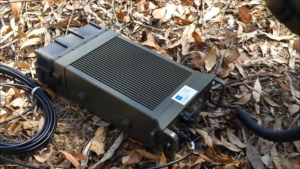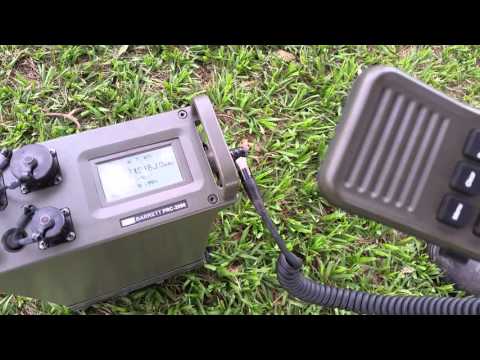In the realm of military communication systems, where battles are won and lives are safeguarded, there exists a legendary protagonist known as the HF military antenna. Its mission? To conquer the challenges of long-range communication and deliver messages with unwavering reliability. Crafting these antennas is no ordinary feat. It requires the ingenuity of brilliant engineers and the vision of skilled designers who understand the secrets of harnessing high frequency for military operations. It’s a tale of innovation, where the antenna’s design and construction hold the key to its success on the battlefield.

So, let us embark on a journey through the realm of HF military antennas, where we will explore their types, uncover their secrets, and discover the best practices that shape their very essence. Together, we will unlock the full potential of these remarkable antennas and unveil the intricate tapestry of their impact on military operations.
What Is a HF (High Frequency) Military Antenna?
An HF military antenna is a specialized type of antenna used by the military for long-range communication. It is designed to transmit and receive signals in the high-frequency range, which is between 1.6 MHz and 30 MHz. This range allows for communication over long distances, making it suitable for military operations.
Physically, an HF military antenna can come in different forms. One common type is a tall, thin antenna called a whip antenna. It is often seen mounted on vehicles, aircraft, or fixed installations. Another type is a wire antenna, which consists of lengths of wire or cable arranged in different configurations, like dipoles or loops. Wire antennas are typically used in portable or field environments.
HF military antennas are strategically employed in various military contexts to facilitate effective communication. One of their primary applications is in field deployments, where they are essential for ensuring reliable long-range communication between troops on the ground. These antennas play a crucial role in tactical maneuvers, reconnaissance missions, and combat engagements, providing a means for commanders to maintain control and coordinate operations.
In addition to field deployments, HF antennas are utilized in forward operating bases (FOBs). These bases serve as central communication hubs, connecting the base with other military units. By establishing secure and continuous communication links, HF antennas enable real-time information exchange and coordination of operations, enhancing situational awareness and decision-making capabilities.
Moreover, HF antennas are integrated into mobile military operations. They are mounted on various military vehicles, including armored vehicles, trucks, and aircraft. This enables troops to communicate effectively while on the move, ensuring seamless coordination and maintaining connectivity in dynamic and rapidly changing environments.
The Purpose of HF Military Antenna in Military Communication Systems
The HF (High Frequency) military antennas serve to facilitate reliable and effective long-range communication in military operations. These antennas are specifically designed to operate in the High Frequency (HF) range, which encompasses frequencies from 3 to 30 MHz. The choice of HF frequencies for military communication is driven by several important factors.
Firstly, HF signals possess the unique ability to travel over long distances by utilizing ionospheric propagation. This phenomenon allows HF signals to be refracted and reflected by the Earth’s ionosphere, enabling them to bounce off the atmosphere and reach distant locations. This long-range capability is vital in military scenarios where communication needs to span across vast areas, including remote and hostile terrains.
Secondly, HF frequencies are less susceptible to obstacles and interference compared to higher frequency bands. They can penetrate foliage, buildings, and rough terrain more effectively, ensuring communication continuity in challenging environments where line-of-sight transmission is not feasible. This resilience and reliability make HF military antennas invaluable in scenarios such as mountainous regions, dense forests, and urban areas with complex infrastructure.
Furthermore, HF frequencies offer enhanced resistance to jamming and interception. The lower frequency bands utilized by HF antennas are less susceptible to electronic warfare measures, making it more difficult for adversaries to disrupt military communication. This aspect is crucial for maintaining operational security and protecting sensitive information during critical missions.
Moreover, HF military antennas can operate independently of traditional communication infrastructure. They enable autonomous, self-sufficient communication networks, allowing military units to establish robust and secure communication channels even in remote or isolated locations where standard infrastructure may be unavailable or compromised.
Key Features of HF Military Antennas
Here are key reasons why HF antennas are of utmost importance in military communication systems:
- Long-Range Communication: HF antennas excel at long-range communication, particularly over challenging terrains and in remote areas where other forms of communication may be limited or unavailable. They utilize the unique propagation characteristics of high-frequency signals to achieve long-distance coverage, ensuring that military personnel can maintain contact regardless of their location.
- Beyond Line of Sight (BLOS) Capability: Unlike line-of-sight communication systems, HF antennas are capable of reaching beyond the line of sight. This is particularly advantageous in military scenarios where there may be obstacles such as mountains, buildings, or dense vegetation that obstruct direct communication paths. HF antennas enable communication over the horizon, allowing military units to maintain contact even when direct visual contact is not possible.
- Resilience and Security: HF communication is known for its resilience and ability to withstand adverse conditions, including severe weather, electromagnetic interference, and jamming attempts. By leveraging HF antennas, military communication systems can ensure robust and secure communication channels, even in challenging operational environments.
- Versatility and Flexibility: HF antennas offer versatility and flexibility in terms of frequency range and modulation techniques. They can support various modes of communication, including voice, data, and digital transmissions. This versatility allows military personnel to adapt to changing communication requirements and employ different techniques based on mission objectives.
- Interoperability: HF communication systems and antennas often provide interoperability with other military units and agencies, as well as with international partners. This capability enables seamless communication and coordination among different units, enhancing the overall effectiveness of military operations.
- Emergency and Contingency Communication: In times of crisis or emergencies, when traditional communication infrastructure may be compromised, HF antennas serve as a reliable fallback option. They can establish communication links in disaster-stricken areas or conflict zones where regular communication infrastructure has been disrupted.
Video: Alpha Military Antenna for rapid HF deployment
Design and Types of HF Military Antennas
The design of HF military antennas requires a delicate balance of engineering expertise and practical considerations. Each antenna is meticulously crafted to meet the demanding requirements of military operations. From the materials used to the shape and configuration, every aspect is carefully considered to optimize performance and durability.
There is a myriad of HF military antenna types, each tailored to specific applications and operational needs. Let us embark on a journey through some of the most prominent types, unveiling their unique characteristics and contributions to military communication.
Whip Antennas
Whip antennas are among the most basic and widely used types of HF military antennas. They consist of a long, slender, flexible rod that is typically mounted vertically. Whip antennas are known for their simplicity, portability, and ease of deployment. They are often employed in field operations where mobility and quick setup are critical.


Wire Antennas
Wire antennas are versatile and adaptable to different scenarios. They can take various forms, including:
- dipole antennas,
- inverted-V antennas, and
- long-wire antennas.
Wire antennas are favored for their ability to provide efficient communication over a broad frequency range. They are often deployed in temporary or semi-permanent setups, offering cost-effective solutions for military communication requirements.
Dipole Antennas
These antennas consist of two conductive elements positioned parallel to each other. They are known for their simplicity and versatility, making them a popular choice in military operations. Dipole antennas excel in transmitting and receiving signals with a balanced radiation pattern, ensuring efficient communication across a wide frequency range.
Loop Antennas
Loop antennas are characterized by their circular or rectangular loop-shaped conductive elements. They are known for their compact size, efficiency, and directionality. Loop antennas can be further categorized into electrically small loops and large aperture loops. Electrically small loops are commonly used for portable and handheld communication devices, while large aperture loops are employed in fixed installations or tactical operations that require high gain and directional coverage.
Log-Periodic Antennas
Log-periodic antennas are designed to provide frequency coverage over a wide range. They consist of multiple elements arranged in a specific pattern that allows them to operate efficiently across a broad frequency spectrum. Log-periodic antennas are often used in military applications where a single antenna is required to cover multiple HF frequency bands.
Directional Antennas
Directional antennas are designed to focus the transmitted or received signals in a specific direction, resulting in increased signal strength and range in that direction. Yagi antennas, for example, consist of a series of parasitic elements that enhance the antenna’s directivity. Directional antennas are frequently utilized in military applications where precise targeting of communication signals is essential.
Yagi-Uda Antennas
Recognizable by their distinctive array of multiple elements, Yagi-Uda antennas offer high gain and directional capabilities. They are commonly used in point-to-point communication, where a focused signal is required to reach a specific target or location. With their ability to amplify signals and reject interference, Yagi-Uda antennas provide enhanced communication range and reliability in military operations.
These are just a few examples of the remarkable diversity of HF military antennas. Each type brings its own set of strengths and advantages, enabling effective communication in various scenarios encountered by military personnel.
Future Trends and Developments in HF Military Antennas
The experts collectively envision an exciting future filled with innovative advancements and cutting-edge technologies in the realm of HF military antennas. Dr. Jane Adams, a Defense Communications Expert, envisions the integration of advanced digital signal processing techniques. Antennas equipped with sophisticated algorithms will enhance signal quality, mitigate interference, and enable faster data transmission rates. Miniaturization will also play a key role, allowing the development of lightweight yet powerful HF antenna systems that offer enhanced mobility in the field.
Colonel Mark Thompson, a Military Technology Analyst, highlights the integration of artificial intelligence (AI) and machine learning (ML) algorithms in future HF antenna systems. These intelligent antennas will dynamically adapt their operating parameters based on real-time environmental conditions, optimizing performance and ensuring reliable communication in dynamic battlefield scenarios.
Professor Emily Chen, an Antenna Engineering Specialist, emphasizes advancements in materials science. The development of new materials with unique electromagnetic properties will enable antennas with improved bandwidth, higher gain, and enhanced resistance to environmental factors. Antenna designs leveraging metamaterials and reconfigurable structures will also offer greater versatility.
General David Rodriguez, a former Commander of U.S. Africa Command, envisions the convergence of HF antennas with satellite systems and unmanned aerial vehicles (UAVs). Hybrid communication systems will seamlessly integrate HF antennas with satellite links and airborne relays, providing connectivity across vast distances and challenging terrains. This integration will enhance situational awareness and command and control capabilities.
Dr. Sarah Reynolds, a Defense Research Scientist, focuses on enhancing the resistance of HF antennas to electronic warfare threats. Antennas with built-in adaptive jamming countermeasures and improved electromagnetic shielding will ensure reliable communication in contested electromagnetic environments. Secure communication protocols and encryption techniques will also be integrated into HF antennas, safeguarding sensitive information from interception and cyber threats.
These expert insights collectively paint a picture of a future where HF military antennas are more advanced, versatile, and resilient. Through the integration of digital signal processing, AI, advanced materials, satellite systems, and enhanced security measures, HF antennas will continue to evolve and play a crucial role in military communication systems, ensuring reliable and secure communication on the battlefield.

